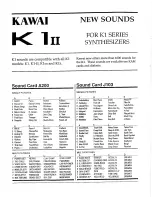
Tone Parameters
21
Parameter
[
K
] [
J
] buttons
Value
[-] [+] buttons
Explanation
Wave Group
INT A
Specifies the wave group that is used
when OSC Type is PCM.
INT B
INT C
Wave Number L
Specifies the wave number within the
group specified by Wave Group.
If using mono, specify only the left side
(L). If using stereo, specify the right side
(R) as well.
If using mono, specify only Wave Number
L and leave Wave Number R at 0: OFF.
If you specify only Wave Number R, no
sound is heard.
Wave Number R
VA Waveform
Specifies the wave that is used when OSC Type is VirtualAnalog.
SAW
Sawtooth wave
SQR
Square wave
TRI
Triangle wave
SIN
sine wave
RAMP
Ramp wave
JUNO
Modulated sawtooth wave
PCM-Sync Wave
Number
Specifies the wave that is used when OSC Type is PCM-Sync.
The PCM-Sync oscillator is effective when specified as the Slave
(the sync-modulated partial 1 or 3) when Structure is set to
SYNC.
Gain
-18–+12 [dB]
Specifies the gain (amplitude) of the
waveform.
The value will change in 6 dB (decibel)
steps.Each 6 dB increase doubles the
gain.
Pulse Width
0–127
This effect is produced when the
waveform is deformed by varying the
duty cycle of the pulse width.
It is effective when OSCType is VA, and is
also effective with waveforms other than
SQR (square wave).
*
If the value is 64, the pulse width has a
50%:50% duty cycle.
*
This effect does not apply to partials 1 and 2.
PWM Depth
-63–+63
Specifies the amount (depth) of LFO
applied to PW (Pulse Width).
LFO uses the settings of LFO2.
Super-SAW
Detune
0–127
Specifies the amount of pitch variance
between the (seven) sawtooth waves that
are layered within one oscillator.
*
As this value is increased, the pitch variance
becomes greater. (At this time, OSC Detune
applies an equal amount of pitch difference
between the seven sawtooth waves.)
*
This has no effect if Structure is SYNC.
*
This is effective only when SuperSAW is
selected as the OSC Type.
Click Type
SOFT, HARD
Changes the sense of attack by varying
the position at which the sound starts.
This is effective if OSC Type is
VirtualAnalog. However, HARD is effective
only when VA Waveform is TRI or SIN.
Fat
0–127
Boosts the low-frequency region.
This is effective when OSC Type is
VirtualAnalog.
FXM Switch
OFF, ON
This sets whether FXM will be used (ON)
or not (OFF).
*
FXM (Frequency Cross Modulation) uses
a specified waveform to apply frequency
modulation to the currently selected waveform,
creating complex overtones. This is useful for
creating dramatic sounds or sound effects.
FXM Color
1–4
Specifies how FXM will perform
frequency modulation.Higher settings
result in a grainier sound, while lower
settings result in a more metallic sound.
FXM Depth
0–16
Specifies the depth of the modulation
produced by FXM.
Parameter
[
K
] [
J
] buttons
Value
[-] [+] buttons
Explanation
Delay Mode
Partial Delay
This produces a time delay between the moment a key is
pressed (or released), and the moment the partial actually
begins to sound. You can also make settings that shift the
timing at which each partial is sounded.
This differs from the Delay in the internal effects, in that by
changing the sound qualities of the delayed partials and
changing the pitch for each partial, you can also perform
arpeggio-like passages just by pressing one key.
You can also synchronize the partial delay time to the tempo of
the external MIDI sequencer.
If Legato Retrigger Interval is other than OFF, legato operation
occurs only when Delay Mode is NORMAL.
Also in this case, Legato Retrigger Interval operates as 0
(retriggers at each DelayTime).
NORMAL
The partial begins to play after the
time specified in the Partial Delay Time
parameter has elapsed.
Note off
Delay time
Note on
No Partial Delay
HOLD
Although the partial begins to play after
the time specified in the Partial Delay
Time parameter has elapsed, if the key is
released before the time specified in the
Partial Delay Time parameter has elapsed,
the partial is not played.
Note off
Delay time
Note on
No sound
played
KEY-OFF-NORMAL
Rather than being played while the key is
pressed, the partial begins to play once
the period of time specified in the Partial
Delay Time parameter has elapsed after
release of the key. This is effective in
situations such as when simulating noises
from guitars and other instruments.
Note off
Delay time
Note on
KEY-OFF-DECAY
Rather than being played while the key
is pressed, the partial begins to play
once the period of time specified in the
Partial Delay Time parameter has elapsed
after release of the key. Here, however,
changes in the TVA Envelope begin while
the key is pressed, which in many cases
means that only the sound from the
release portion of the envelope is heard.
Note off
Delay time
Note on
Delay Time Sync
OFF, ON
Set this ON if you want the partial delay
time to synchronize with the tempo.
Delay Time
(note)
1/64T–2
This is available when Delay Time Sync is
ON. It specifies the delay time in terms of
a note value.
Delay Time
0–1023
This is available when Delay Time Sync is
OFF. It specifies the delay time without
regard to the tempo.








































